Montessori is our way of life at home. I do my best to provide a respectful, inviting and conducive environment for my toddler where she can explore sensorially, follow her interests and have lots of opportunities to contribute to the household. My toddler thrives on the Montessori way of child-led learning and it is heartening beyond measure to see how it grows her into a self-directed child.
In our Montessori home, as much as my budget allows, I try to provide my toddler with high-quality, sturdy and natural-based (e.g. wooden) Montessori-friendly toys. I am selective about toys to invest in, mostly going for open-ended toys that can be manipulated in myriad ways and can grow with my toddler's developmental stages.
To supplement expensive Montessori toys, I began to create homemade Montessori-inspired toys -- recyclables, nature loose parts and existing toys -- with everyday materials at home, tailored to my toddler's developmental needs. Montessori-aligned toys don't have to be fancy; they just have to leverage Montessori principles to be thoughtfully constructed.
10+ Homemade Montessori-inspired Toys for Toddlers
1. Geoboard
A geoboard is a mathematical tool which allows for exploration of geometrical concepts and learning about shapes like triangles, other polygons, symmetry, angles as well as fractions. It is typically a wooden board with nails half inserted and geo (rubber) bands are wrapped around the nails. A geoboard can be commonly found in Montessori classrooms and homes.
I created my homemade geoboard using a sturdy cardboard box, cut straws, hot glue and rubber bands (from fresh produce packaging). I used a pen knife to cut small slits in the box approximating equal distances among the straws, inserted shortened straws and then used hot glue gun to secure straws to the cardboard.

To enhance safety, masking tape could be taped onto the 'jutting' ends of the straw. The straws I used weren't very stiff, so I didn't blunt the straws with tape. As with all geoboards, I would recommend play on a table and not the floor (to prevent accidents of falling or stepping onto the geoboard) and supervision of the child at all times.

I like to provide cardboard cards with written numerals or Chinese characters for my toddler to practise shaping the rubber bands into similar shapes and patterns.

Apart from developing the mathematical brain, geoboard work builds children's three-finger grip and hand/finger dexterity, preparing them for later skills like writing.


This activity is a science lesson in itself. By exploring, stretching and flicking the rubber bands, children can make scientific observations and learn about elastic and potential energy.

2. Spindle box
The Montessori spindle box is a math tool that introduces counting with the use of wooden spindles. The spindle box typically consists of two boxes, one with a lid consisting of 45 wooden spindles as well as an open box labelled 0-9 and divided into 9 compartments.
I created my homemade spindle box from milk carton boxes, hot glue, white paper with written numerals and colourful popsicle sticks from Dollar Tree (substituting wooden spindles). Note: Popsicle sticks do not have to be colored, I only had colored ones at home.

The spindle box is self-correcting, since the precise number of wooden spindles to fill the compartments is provided. When a child finishes counting and realises there are leftover or too few spindles, the child knows there is an error and can do a recount again.



Other Montessori math materials that can be DIY-ed include cards and counters as well as sandpaper numerals.

3. Nesting
Solid wooden nesting boxes are often used in Montessori classrooms and homes. Well-crafted Russian Matryoshka nesting dolls are popular for children to practise nesting too.

Nesting yields many benefits such as building visual and spatial perception, visual discrimination, problem-solving and critical thinking skills.
I created this homemade nesting toy by recycling container lids and sticking velcro dot stickers on them. This idea originated from Laly Mom.
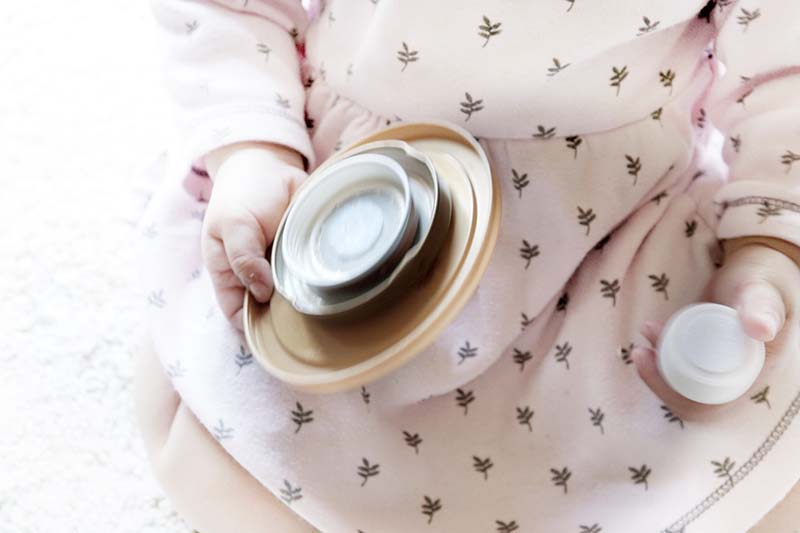
Refer to an earlier post for other Montessori-inspired problem-solving activities for toddlers.

4. Hammering
The benefits of hammering toys include building motor planning, hand-eye coordination, arm/hand strength and concentration.
This hammering activity is created using an empty egg carton, real metal nails, a wooden hammer (from this tool set).
I used a pen knife to cut a small slit in the egg crate, position the nail into the slit slightly, and demonstrate hammering of the nail into the egg carton. It is important not to make too big a slit so there is tactile resistance to knocking the nail in.

After a few rounds of observation, I let my toddler take over the hammering.

A book accompaniment for this activity would be The Toolbox, which introduces names of various hand tools in the toolbox.

Other DIY hammering setups I have seen are golf tees and styrofoam, nails and cork board as well as golf tees and clay.
5. Threading
Threading is one of the practical life activities that allow children to independently work on tasks they see grown-ups accomplish and 'fix' things, allowing them to acquire a useful skill, gain confidence as well as hone fine motor abilities.
When starting out in threading, these are the easy setups I created for my toddler:
- Breast pump tube and TP rolls
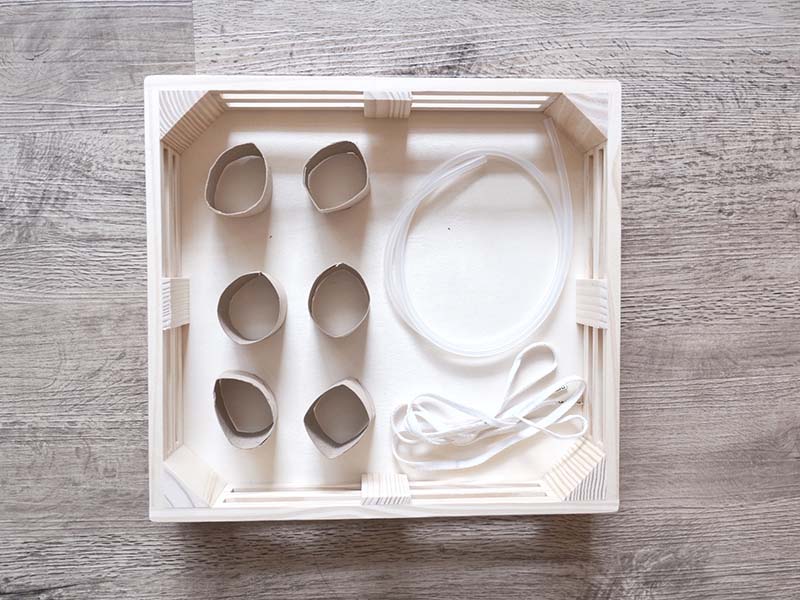
This is great for beginning threaders because the tube is stiff and easy to grip and insert into the cardboard tube holes vs. shoelaces.
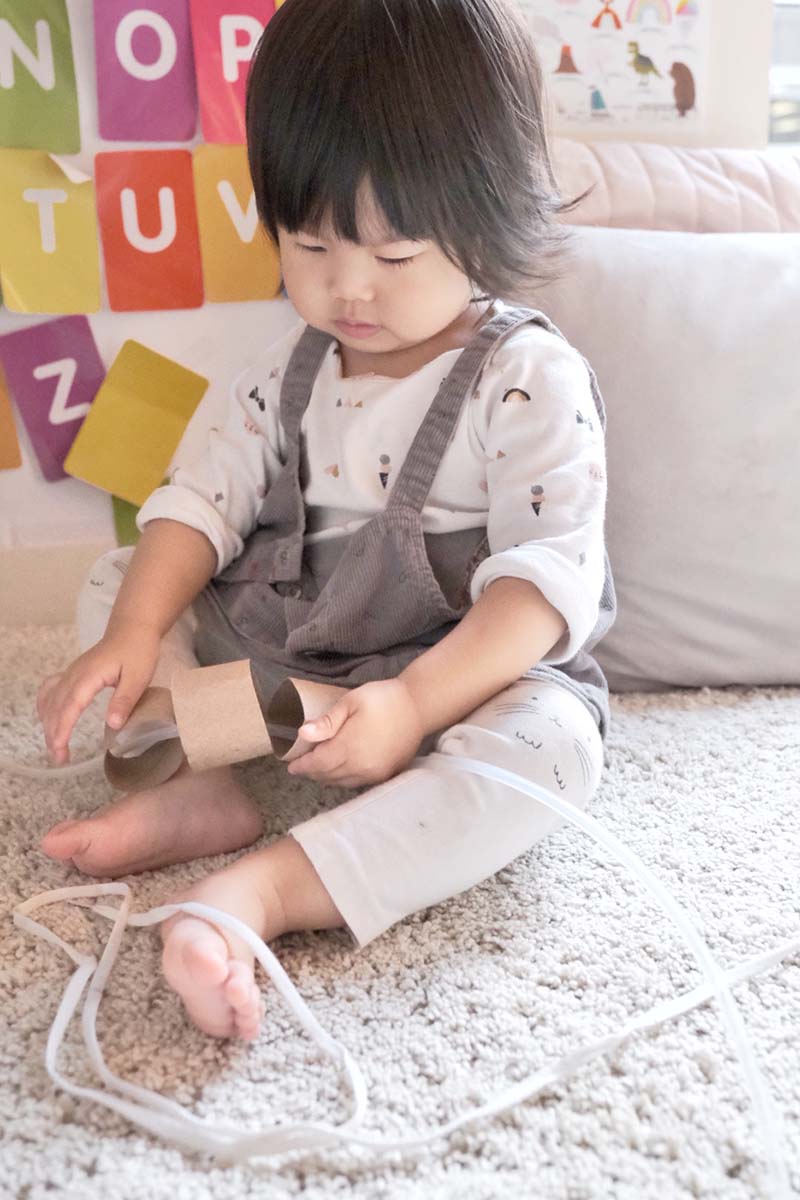
Tip: Cardboard tubes can be re-sized (cut a section out and tape together) to become smaller to increase the difficulty level.
- Penne pasta and pipe cleaners
When you have expired penne pasta, this is a great way to recycle them.
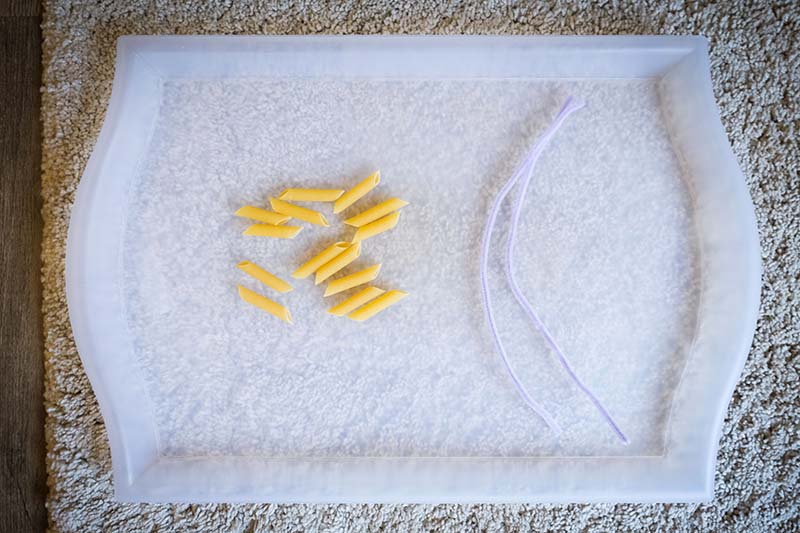
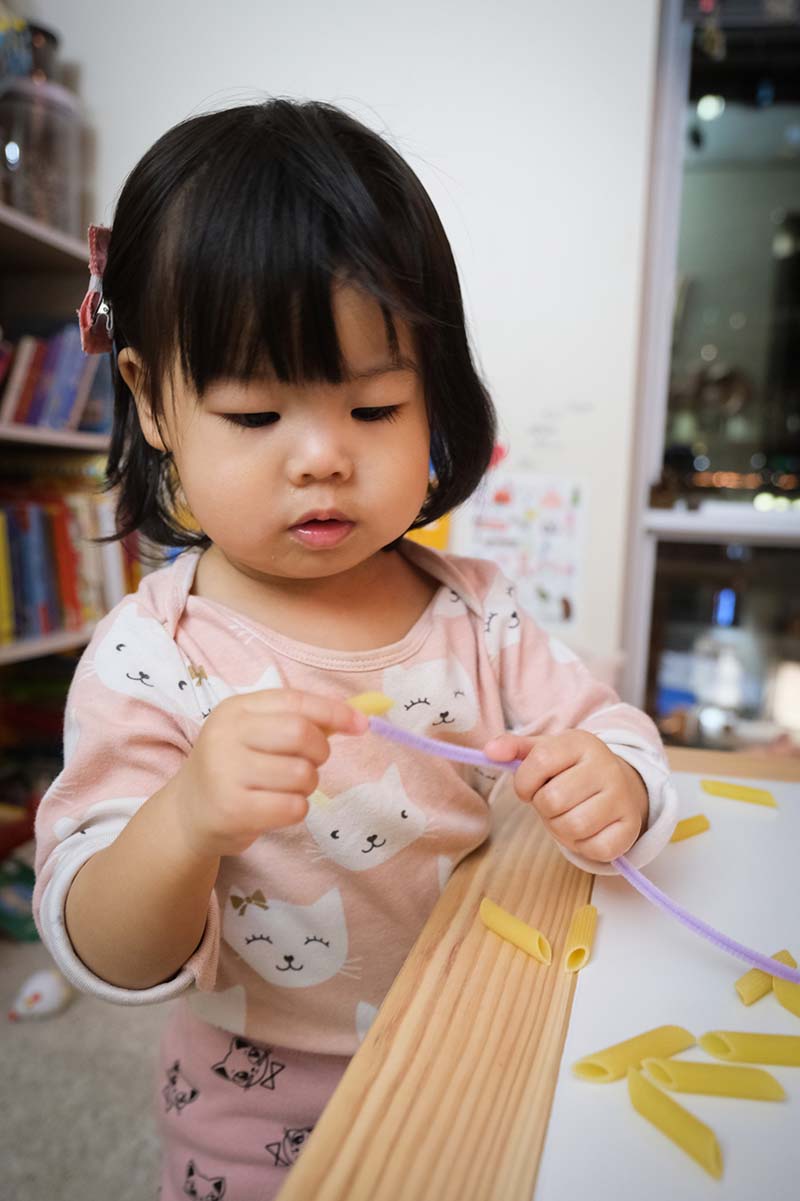
Compared to the above setup, this required stronger hand-eye coordination, aim and focus to insert the pipe cleaners through the small holes of the pasta pieces.
- Paper plate and shoelace
After a number of threading experiences, my toddler graduated to threading with shoelaces. Here I punched holes all around an upcycled paper plate for her to thread the shoelace into.
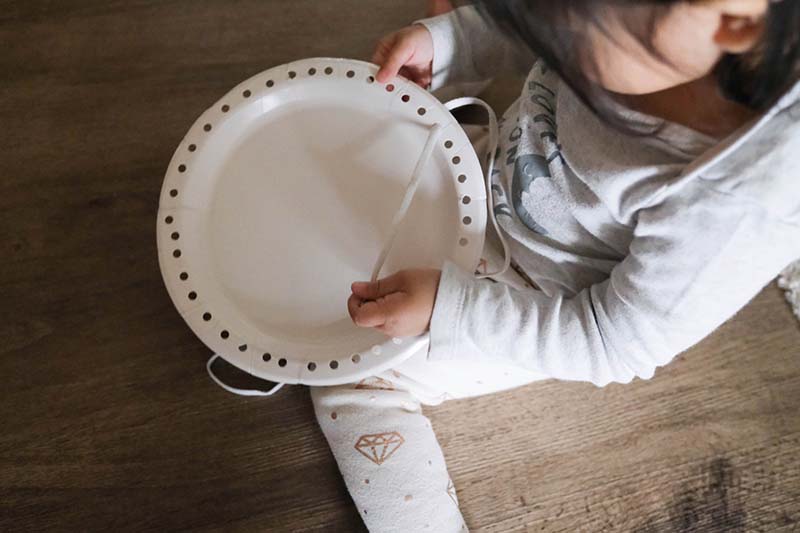
To pique children's interest in the activity, you could decorate the material to bring out a relevant and interesting theme that appeals.

Here's an orange and pineapple cardboard threading toy from my Chinese New Year Montessori-inspired tray activities.
- Colander and shoelaces
My toddler was the one who actually discovered that shoelaces could be threaded into her DUKTIG cookware colander.
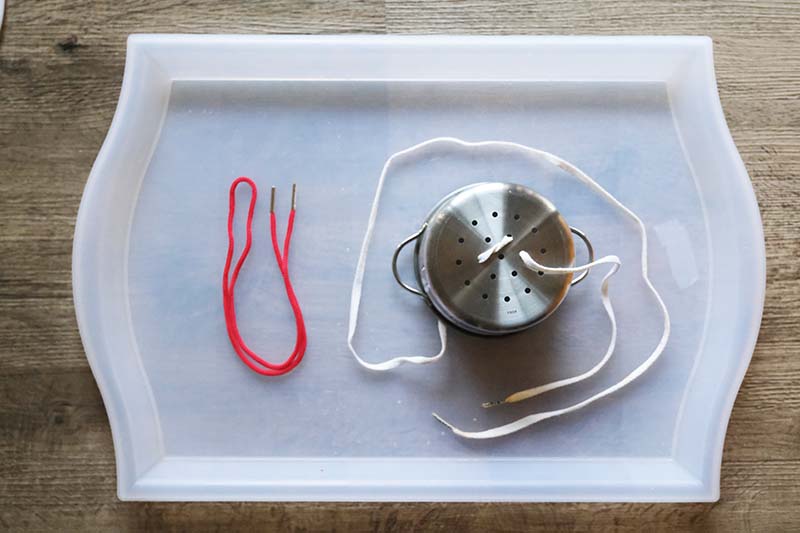
As such, I laid the required resources out on a tray for her to master the threading through repetitive tries.

6. Shoelace Tying
Putting shoes on is such an important aspect of getting dressed and mastering this skill allows children to take care of their own dressing need independently.
The time hasn't come for my toddler to graduate from her velcro shoes to shoelace shoes, but she has taken an interest in tying my and Daddy's shoes for us right before we leave the house, often refusing to go until she has tried her hand at our shoelaces.
As such, I created a cardboard shoelace tying toy from an illustrated cardboard and a spare shoelace for her to explore and work her fine motor skills and improve bilateral coordination.

My focus here is not the technical bow tying or memorisation of steps to make that happen. It is to help my toddler visualise how the shoelaces could be put together, help her problem-solve and satiate her curiosity on how things work.

I would say this is a great primer activity to scaffold skills required for eventually mastering the technique of shoelace tying. When the time comes, I would probably set aside a real shoe for my child to practise for more realism and to better set her up for self-care success.

7. Sewing
Sewing is an important Montessori practical life activity. It develops fine-motor skills and builds concentration as well as prepare children for “real handwork” projects in the future.
Typically, sewing setups involve an embroidery floss and a sewing hoop. When my toddler saw me sewing one day and wanted to give it a go, I created a sewing kit for her by DIYing a cardboard needle.

I fashioned cardboard pants and heart-shaped 'buttons' for my toddler to sew onto the cardboard pants.

As my toddler is experienced with threading, she could move the cardboard needle through the cardboard holes smoothly. I just had to guide her to thread the needle through the same hole a few times to secure the button to the pants.




I think it would be nice to use this sewing activity to make festive hand-sewn crafts for families and friends.

8. Number board
The Montessori Hundred Board is used to teach number sequencing from 1 to 100 and used by placing wooden chips in sequence on the board. The board consists of 100 printed wooden chips stored in a wooden box with a lid as well as a wooden board with 100 labelled squares.
I created a toddler-friendly version, which I'll term as an 'egg crate number board'. It is a simplified version of the Hundred Board, tailored for toddlers familiarising themselves with numerals from 0 to 20. I created this number board using egg crates and bottle caps.


I trimmed and joined two egg crates to fit 20 bottle caps then glued labelled paper circles onto the inside of bottle caps for my toddler to place the bottle caps into the compartments of the egg crates.


This homemade toy is flexible and can grow with my toddler. Once my toddler is familiar with numeral recognition from 1 to 20, I would add more rows of egg crates to include more numerals.
Note: Hallie reached out to share that it's a better idea to separate the top and bottom compartments of the egg crates and fasten them side-by-side so numerals 1-10 are in a row and 11-20 are in the next row. This is because the Montessori approach uses a base 10 numerical system. This modification would allow children to visualize and learn that way. Thanks Hallie!

9. Color sorting
Toddlerhood is a time when most children naturally enter into the sensitive period for order and color sorting materials at home is an inexpensive and quick way to fulfil my toddler's need for creating order and interest in sorting.
These are some of the everyday household items I've used for color sorting activities.
- Pom pom balls
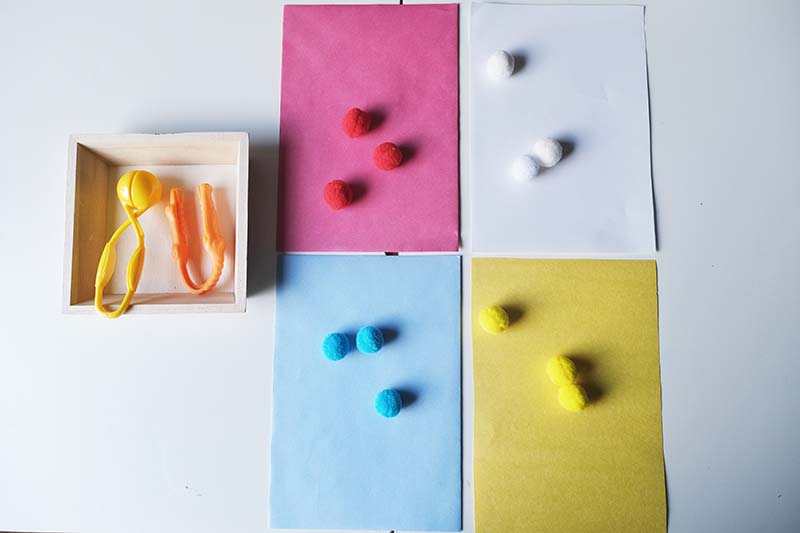
- Loom bands

- Dot stickers (idea originator: Busy Toddler)
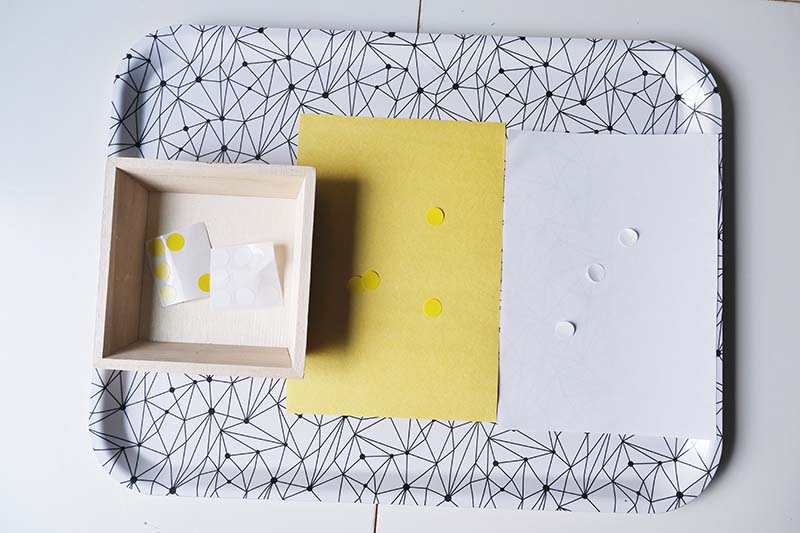
- Sealing clips

- Play dough

Other size sorting activity setups using everyday home materials here.

11. Size sorting
I attempted size sorting activities with my toddler after color sorting ones because they are more challenging and require some form of prompting like, "Which is the next smallest/largest?" until the grading is complete.
With size sorting, it might be helpful for beginning sorters to use tracing cards to help with visual discrimination of sizes.
These are some of the everyday household items I've used for size sorting activities at home:
- Cutlery
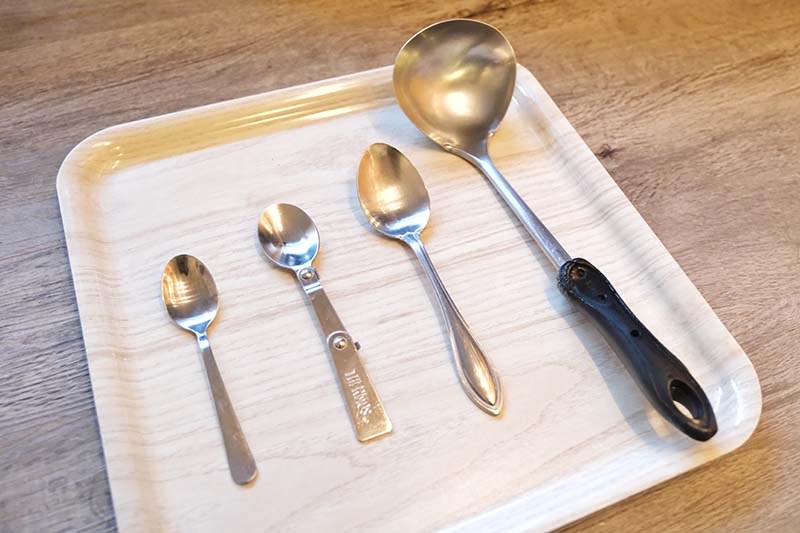
- Measuring cups

- Cookie cutters

- Vegetables like ginger root
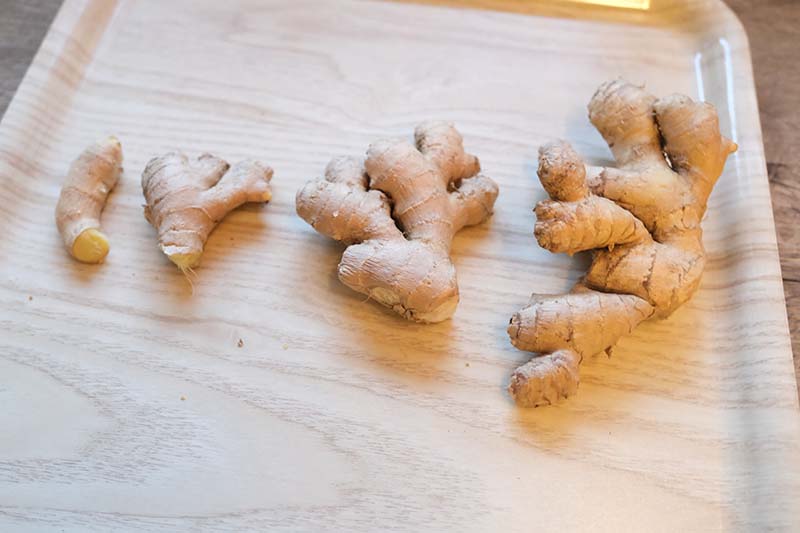
Other size sorting activity setup with everyday home materials here.

12. Home Cleaning Tools for Practical Life Activities
To help young children become successful at everyday tasks, it is important to scaffold skills that allow them to independently care for themselves as well as the environment they live in.
Ever since my toddler took interest in reinstating order around the house (e.g. putting a toy back on shelf), these are some of the child-sized materials I've equipped her with:
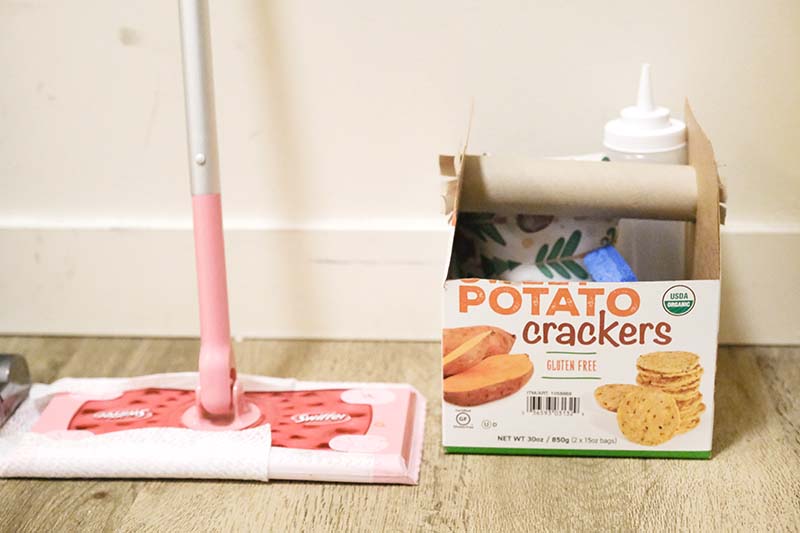
- Homemade cleaning caddy
In this homemade cardboard caddy, I typically place a half-filled squeeze bottle, small towel, wet wipes, sponge etc. My toddler has access to this at all times and can independently retrieve it for cleaning spills or furniture (table) when the need arises.
- Shortened swiffer
I took out two sections of the swiffer to tailor its length to my toddler's height. Thanks to an Instagrammer who shared with me that swiffers are height-adjustable!
My toddler has access to the cleaning sheets for the swiffer and helps to fit them onto the swiffer when we clean the house.

13. Salt Writing Tray
Salt writing trays are Montessori-style activities for children to learn and practise writing numerals and letters, with the tactile input from the salt helping them to retain more. The finger makes a great pre-writing tool for young children before they master pencil grip and use.


Salt writing appeals to the sense of sight, touch and sound, and is great for kinesthetic learners.


It is wonderful for promoting pre-writing skills (without the pressure of getting a correct pencil grip), and strengthening fine motor abilities.


I provide cardboard cards with numerals in English and Chinese for her to copy the designs. Repetitive handwriting in the sand builds muscle memory and enables children to eventually translate the writings to pencils with the use of a pencil.
After each tracing, I tilt the shoebox lid gently to its side to level the salt. I also provide a large tray beneath the shoebox lid to catch any salt that falls out during writing practice.

Other Homemade Montessori-inspired Toys
These are DIY toys from other Montessori practitioners which I found really inspiring and useful!
- Mercy for Marthas
- Living Montessori Now
- Montessoriish Mom (toys tailored for babies/toddlers between 10-15 months)
- Life Gate
To follow our play adventures, follow our Instagram, Pinterest or Facebook Group.

Note: I am not trained in Montessori, so all of the above information is derived from my own research and understanding of the Montessori method as well as my education and experience working with young children.
